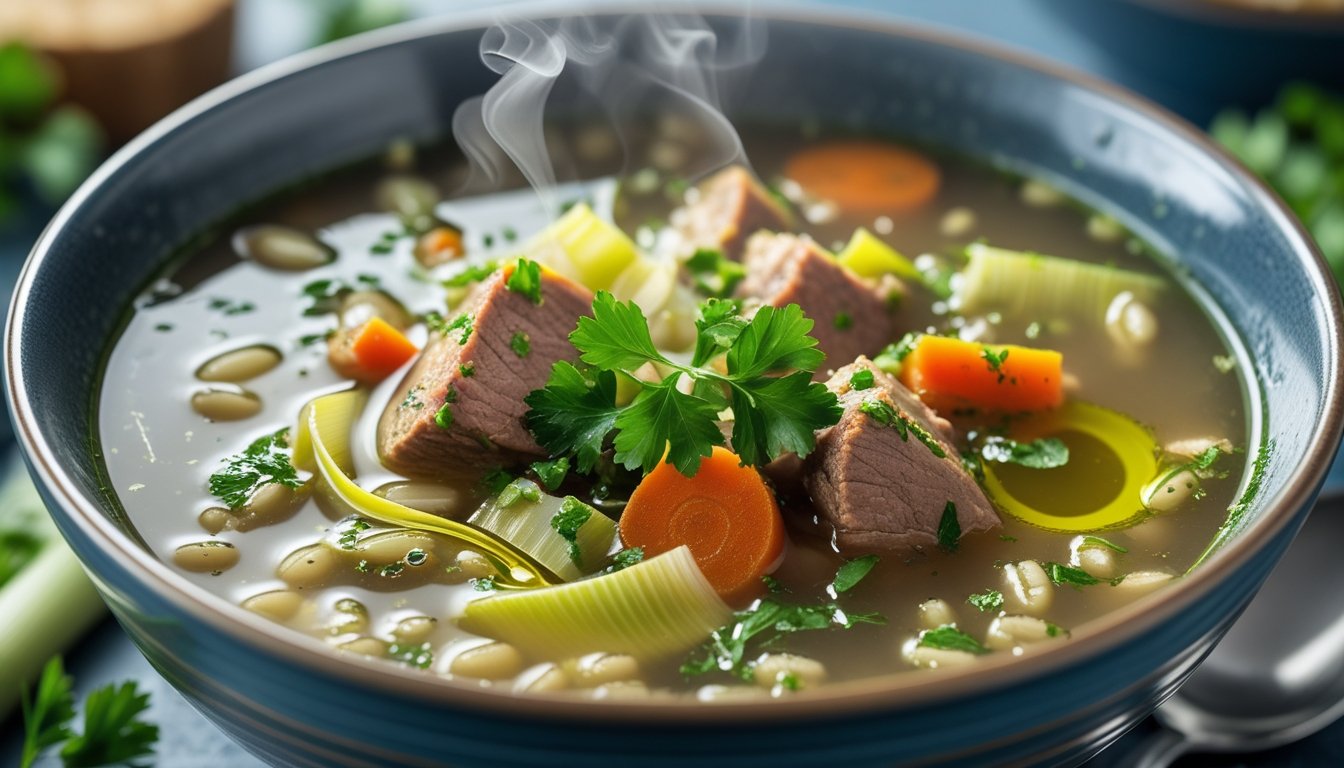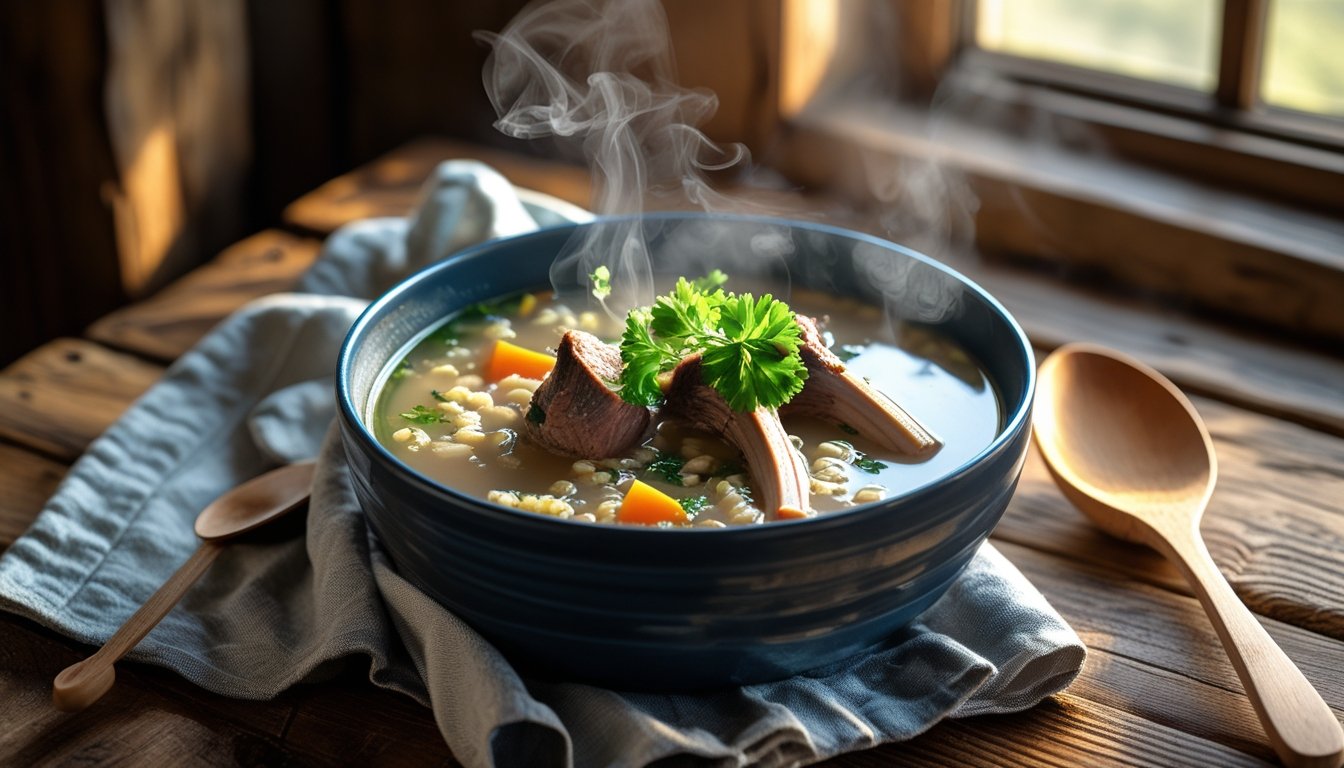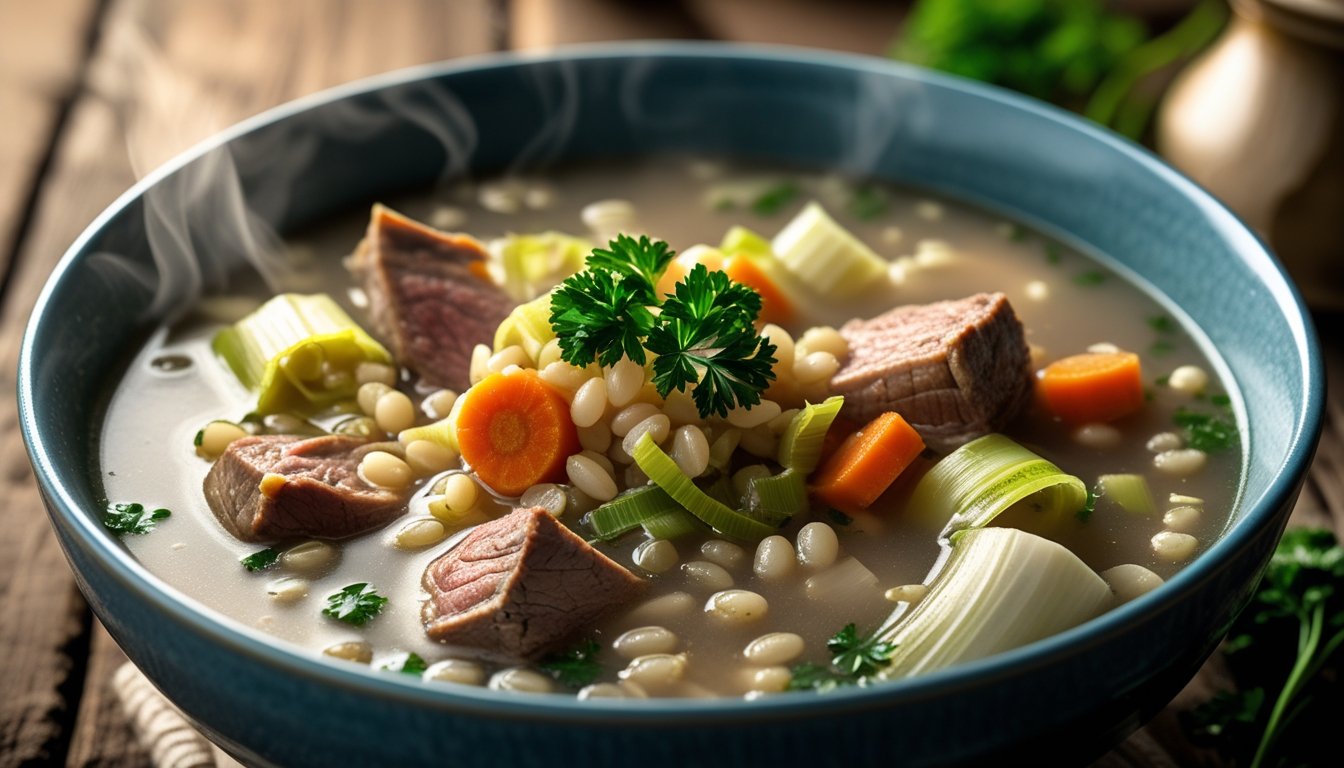You know those cold days when even your socks feel emotionally defeated? Yeah, that’s when Scotch Broth swoops in like the hero of comfort food. This Scottish soup recipe isn’t just a dish—it’s a mood. It’s hearty, wholesome, and feels like someone wrapped you in a tartan blanket and said, “Everything’s gonna be fine.”
I first stumbled upon Scotch Broth during a trip through the Highlands (yes, where sheep outnumber humans). I ordered it on a whim, and one spoonful later, I was hooked. Ever since, it’s become my go-to recipe whenever I need some edible therapy.
So, grab your apron, a big pot, and let’s chat about this cozy, barley-loaded, flavor-packed wonder that the Scots have perfected. Ready? Let’s get your kitchen smelling like a countryside inn.
To make Scotch Broth, start by simmering lamb or mutton shanks in water, skimming off any foam for a clear broth. Add onions, celery, and herbs like thyme and parsley for aromatics, and let it cook until the meat is tender.
Next, introduce pearl barley, which thickens the soup and adds a chewy, comforting texture. Finally, add chopped root vegetables and simmer until all ingredients are cooked perfectly. Shred the lamb back into the pot, season with salt and pepper, and you’ll have a bowl of cozy, wholesome Scottish soup ready to enjoy.
This soup is not only delicious but also packed with nutrients—protein from lamb, fiber from barley, and vitamins from fresh vegetables—making it a complete meal in itself. It stores well, tastes even better the next day, and is easily adjustable for personal tastes or dietary preferences.
For those craving a hearty and authentic Scottish experience, the Scotch Broth Scottish Soup Recipe complete recipe is given below.

What Exactly Is Scotch Broth?
Let’s clear the air—Scotch Broth isn’t just “another soup.” It’s a time-honored Scottish classic known for its comforting mix of lamb (or mutton), barley, root vegetables, and herbs. Think of it as the Scottish version of chicken noodle soup… only heartier, richer, and, dare I say, way more satisfying.
Traditionally, it was a peasant dish—simple ingredients simmered for hours until magic happened. But don’t be fooled by its humble roots. When done right, Scotch Broth delivers layers of flavor that rival any fancy restaurant meal.
Ever wondered why the Scots swear by it during winter? Because it warms you from the inside out—like a whisky, but without the regret.
Ingredients You’ll Need (AKA: The Usual Suspects)
Here’s the beauty of this dish—you don’t need rare ingredients or fancy gadgets. Just simple, real food that does the job.
Main Ingredients:
- Lamb or mutton shank – the soul of the broth (go for lamb if you prefer milder flavor)
- Pearl barley – the secret to that hearty, velvety texture
- Carrots, leeks, and turnips (or swedes) – root veggies bring depth and sweetness
- Onions and celery – the aromatic backbone of any good soup
- Fresh parsley and thyme – herbs that make everything better
- Salt and black pepper – because flavor matters, obviously
Optional Add-ons (if you feel fancy):
- A handful of shredded cabbage or kale near the end
- A splash of Worcestershire sauce for umami
- A squeeze of lemon for a fresh kick
Pro Tip: Don’t skimp on the barley. It’s what gives the broth that satisfying thickness that says, “Yes, I’m a meal, not just a starter.”
Step-by-Step: How to Make Authentic Scotch Broth
Making Scotch Broth is like storytelling—it unfolds slowly, builds character, and leaves you feeling warm inside. Here’s the breakdown:
Step 1: Start with the Meat
Place your lamb shank in a large pot and cover it with cold water. Bring it to a gentle boil, then skim off the foam (aka the “why-is-this-here?” stuff). This keeps your broth clear and lovely.
Step 2: Let the Magic Simmer
Add in your onions, carrots, celery, and herbs. Reduce to a simmer and let it cook for about 1.5 to 2 hours—or until the meat is falling off the bone. You’ll know it’s ready when your kitchen smells like heaven.
Step 3: Barley Time
Remove the lamb, strain the broth, then pour it back into the pot. Add your barley and cook for another 45 minutes. Stir occasionally so it doesn’t cling to the bottom like a clingy ex.
Step 4: The Veggie Finale
Add the remaining chopped veggies (turnip, leeks, and maybe cabbage if you’re feeling wild). Simmer for another 20–30 minutes until everything is tender.
Step 5: Shred & Serve
Shred the lamb and stir it back into the pot. Season with salt and pepper to taste, and there you have it—a steaming bowl of Scottish soul food.
Why You’ll Fall in Love with This Soup
You know when food is so good you close your eyes on the first bite? Yeah, that’s what Scotch Broth does.
Here’s what makes it the ultimate comfort dish:
- Hearty and filling: One bowl and you’re satisfied (no mid-evening snack hunting).
- Nutritious: Packed with protein, fiber, and vitamins—basically a balanced meal in a bowl.
- Budget-friendly: Uses affordable ingredients you probably already have.
- Meal-prep gold: Tastes even better the next day.
- Cultural charm: You’re literally eating a piece of Scotland’s culinary heritage.
Honestly, if soup had a “cozy level,” Scotch Broth would break the scale.
A Little History (Because Food Stories Matter)
Scotch Broth dates back centuries—it’s the OG of Scottish comfort cooking. Originally, farmers made it with mutton and barley, both staples of the land. Barley was the Scots’ go-to grain, and mutton was, well, what they had around.
What’s cool is how this dish evolved. Over time, people started swapping mutton for lamb and experimenting with different veggies. But even after all that evolution, the heart of the recipe never changed—it’s still about wholesome ingredients and slow cooking.
It’s the kind of meal that connects you to generations before you. Think about it—you’re eating something that Scottish families enjoyed long before Netflix and delivery apps existed. Talk about timeless.
Texture and Flavor: What to Expect
If you’re expecting a thin, broth-y soup—prepare to be surprised. Scotch Broth is thick, rustic, and full-bodied. Every spoonful delivers chewy barley, tender lamb, and soft veggies that melt in your mouth.
The flavor? Deep and comforting, with subtle sweetness from the root vegetables and an earthy richness from the lamb. It’s the culinary equivalent of listening to rain while wrapped in a blanket.
Common Mistakes to Avoid
Alright, let’s be real. Even the simplest recipes can go south if you’re not careful. So, here’s a quick list of what not to do:
- Rushing the simmering: This isn’t instant ramen. The longer you cook it, the richer the flavor.
- Skipping the barley soak: Barley expands—a lot. Rinse it first, or your broth might turn into stew (not that it’s the worst problem).
- Using too much salt early: The broth reduces over time, so salt at the end for better control.
- Forgetting the lamb bones: Bones add collagen and depth. Don’t skip them unless you love bland soup.
Remember: Scotch Broth rewards patience. It’s a slow game, but the payoff? Totally worth it.

Health Benefits (Because Comfort Food Can Be Good for You Too)
This isn’t just cozy—it’s actually good for you. Let’s break it down:
- Lamb = Protein Powerhouse: Great for muscle repair and keeping you full longer.
- Barley = Fiber Boost: Helps digestion and supports heart health.
- Veggies = Vitamins Galore: Carrots, leeks, and turnips add antioxidants and minerals.
- Low Waste Cooking: You use bones, meat, and veggies completely—less food waste, more flavor.
Basically, Scotch Broth lets you eat healthy without feeling like you’re “eating healthy.” Win-win.
Make It Your Own: Fun Variations to Try
Want to put your spin on this classic? Go for it! Scotch Broth is forgiving, flexible, and loves creativity.
- Vegetarian Twist: Swap lamb for mushrooms and veggie stock. Add lentils for protein.
- Modern Shortcut: Use Instant Pot or slow cooker—same flavor, less time.
- Flavor Boosters: Add a dash of smoked paprika or a splash of sherry vinegar at the end.
- Garnish Goals: Top with crispy fried onions or fresh herbs for restaurant-level flair.
Who says tradition can’t have a little fun? 🙂
What to Serve with Scotch Broth
If you want to go full Scottish, pair your broth with:
- Crusty bread or oatcakes – for dunking, obviously.
- Mashed potatoes – because carbs + carbs = happiness.
- A wee dram of Scotch whisky – optional, but highly recommended if you’re off duty.
Pro tip: Serve it in a deep bowl, drizzle a bit of olive oil or melted butter on top, and you’ve just upgraded your dinner game.
Storage & Reheating Tips
Scotch Broth is like fine wine—it gets better with age. The flavors deepen overnight, making it perfect for meal prep.
- Storage: Keep it in the fridge for up to 4 days or freeze for up to 3 months.
- Reheating: Warm it gently on the stove. If it thickens too much, add a splash of stock or water.
FYI, frozen Scotch Broth reheated on a lazy Sunday tastes just as amazing as the day you made it.
Final Thoughts: Comfort in Every Spoonful
There’s something magical about food that feels nostalgic, nourishing, and downright delicious. Scotch Broth checks every box. It’s hearty without being heavy, traditional yet timeless, and, honestly, one of the most underrated soups on the planet.
So next time you’re craving comfort, skip the instant noodles and make a pot of Scotch Broth instead. You’ll get warmth, flavor, and that unbeatable “home-cooked happiness” feeling in every spoonful.
FAQs
1. What is Scotch Broth?
Scotch Broth is a traditional Scottish soup known for its hearty and wholesome nature. It combines lamb or mutton, barley, split peas, and a variety of root vegetables like carrots, leeks, and turnips. This rustic dish has been a staple in Scottish cuisine for centuries, offering both nourishment and comfort.
2. What are the essential ingredients for Scotch Broth?
A classic Scotch Broth includes:
- Lamb or mutton (often bone-in cuts like shanks or neck)
- Barley (typically pearl barley)
- Split peas (green or yellow)
- Root vegetables: carrots, leeks, turnips, and sometimes parsnips
- Vegetable stock or meat stock
- Herbs: thyme, bay leaves, and parsley
- Salt and pepper to taste
These ingredients come together to create a rich, flavorful broth that’s both filling and satisfying.
3. Can I make a vegetarian version of Scotch Broth?
Absolutely! For a vegetarian Scotch Broth, simply substitute the meat with vegetable stock and omit the meat entirely. The combination of barley, split peas, and root vegetables ensures the soup remains hearty and flavorful without the need for meat.
4. How long does Scotch Broth take to cook?
- Traditional stovetop method: Simmering the soup can take approximately 2 to 3 hours to ensure the meat is tender and the flavors meld.
- Slow cooker method: Using a slow cooker can take about 6 to 8 hours on low heat, making it convenient for busy days.
Regardless of the method, the key is to cook the soup slowly to develop its rich flavors.
5. Can I freeze Scotch Broth?
Yes, Scotch Broth freezes well. Allow the soup to cool completely before transferring it to airtight containers or freezer bags. It can be stored in the freezer for up to 3 months. When reheating, you may need to add a bit of water or stock to reach the desired consistency, as the soup may thicken upon freezing.
6. What should I serve with Scotch Broth?
Scotch Broth is a complete meal on its own, but it pairs wonderfully with:
- Crusty bread or oatcakes
- Tattie scones
- Bannocks (traditional Scottish scones)
These accompaniments add texture and enhance the overall dining experience.
7. Can I use beef instead of lamb or mutton?
While lamb or mutton is traditional, beef can be used as a substitute. Opt for cuts like beef shank or short ribs, which offer a similar texture and flavor profile. The choice of meat will slightly alter the taste but will still yield a delicious broth.
8. How do I store leftovers?
Store leftover Scotch Broth in an airtight container in the refrigerator for up to 3 to 4 days. Reheat thoroughly before serving. If the soup thickens upon standing, simply add a bit of water or stock to reach the desired consistency.
9. Can I add other vegetables to Scotch Broth?
Scotch Broth is quite versatile. Feel free to add or substitute vegetables like cabbage, kale, or celery based on personal preference or seasonal availability. The key is to maintain a balance of flavors and textures.
10. Is Scotch Broth gluten-free?
Traditional Scotch Broth contains barley, which is not gluten-free. For a gluten-free version, substitute barley with gluten-free grains like quinoa or rice. Ensure that all other ingredients, especially stock, are also gluten-free.

